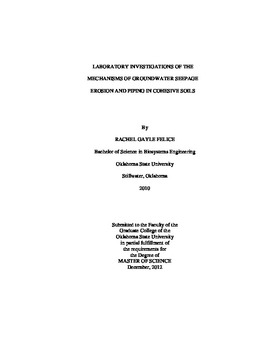| dc.contributor.advisor | Fox, Garey | |
| dc.contributor.author | Felice, Rachel Gayle | |
| dc.date.accessioned | 2014-04-17T19:55:57Z | |
| dc.date.available | 2014-04-17T19:55:57Z | |
| dc.date.issued | 2012-12-01 | |
| dc.identifier.uri | https://hdl.handle.net/11244/10119 | |
| dc.description.abstract | Seepage and soil piping are two mechanisms that can cause streambank erosion and failure. Groundwater seepage can cause erosion either by undercutting or "pop-out" failure. The objective of the seepage study was to utilize a constant-head soil box packed with sandy loam soils at prescribed bulk densities (1.30-1.70 Mg m-3) and an outflow face at 90. Bulk density controlled the mechanism of seepage erosion/failure. For both soils, tension failures occurred at densities less than 1.60 Mg m-3 and undercutting was observed for densities 1.60 Mg m-3 or greater. Data from experiments was used to calibrate SEEP/W to determine pore-water pressures. SLOPE/W utilized the pore-water pressures to determine stability. SLOPE/W only incorporates pore-water pressure effects in factor of safety calculations; therefore, the model was unsuccessful at predicting a failure. Seepage gradient forces may play a more prominent role in streambank and hillslope instability, and this mechanism should be incorporated into stability models. In addition, soil pipe experiments were conducted and flow and internal erosion data were derived for two soils packed at uniform bulk densities but different initial moisture contents. Soils included were clay loam (Dry Creek) and sandy loam (Cow Creek). Initial gravimetric moisture contents (MC) were 10, 12 and 14% for Dry Creek soil and 8, 12, and 14% for Cow Creek soil. A 1-cm diameter rod created the horizontal pipe. A constant head was maintained; flow rates and sediment concentrations were measured from the pipe outlet. Submerged jet erosion tests (JETs) derived erodibility parameters. Flow rates from the box experiments calibrated the deterministic model. The influence of the initial MC of the packed soil was apparent with some pipes (8% MC) expanding so fast that limited data was collected. The deterministic model estimated equivalent flow rates, but had difficulty matching observed sediment concentrations when pipes rapidly expanded by internal erosion. The submerged JETs predicted similar erodibility coefficients compared to the deterministic model for the more erodible cases (8 and 12% MC), but not for the less erodible cases (14% MC). | |
| dc.format | application/pdf | |
| dc.language | en_US | |
| dc.publisher | Oklahoma State University | |
| dc.rights | Copyright is held by the author who has granted the Oklahoma State University Library the non-exclusive right to share this material in its institutional repository. Contact Digital Library Services at lib-dls@okstate.edu or 405-744-9161 for the permission policy on the use, reproduction or distribution of this material. | |
| dc.title | Laboratory Investigations of the Mechanisms of Groundwater Seepage Erosion and Piping in Cohesive Soils | |
| dc.type | text | |
| dc.contributor.committeeMember | Wilson, Glenn | |
| dc.contributor.committeeMember | Bulut, Rifat | |
| osu.filename | Felice_okstate_0664M_12453.pdf | |
| osu.college | Engineering, Architecture, and Technology | |
| osu.accesstype | Open Access | |
| dc.description.department | School of Civil & Environmental Engineering | |
| dc.type.genre | Thesis | |
| dc.subject.keywords | failure | |
| dc.subject.keywords | internal erosion | |
| dc.subject.keywords | piping | |
| dc.subject.keywords | seepage | |
| dc.subject.keywords | soil erodibility | |
| dc.subject.keywords | streambank stability | |
